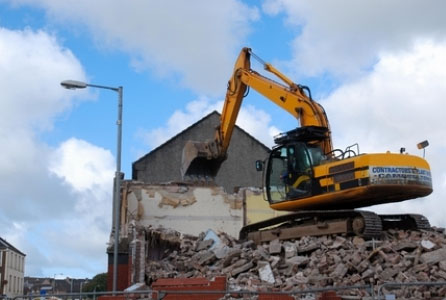
Demolition Risk Assessment
Whenever starting a project involving demolition of any sort, it is prudent and necessary to analyze, evaluate, and create a demolition risk assessment plan. Not only do you want the structure to be removed as quickly and as efficiently as possible, but you need the surrounding areas, the passing public, and your own workers to be safe during the entire process.
How to Begin a Demolition Risk Assessment
One of the first steps during the creation of a demolition risk assessment plan is to determine what hazards could potentially pose problems. These hazards can be observed during site inspections, which should be continuously done throughout the length of the demolition project. These hazards range from having an evacuation plan for employees to making sure that workers are certified for various tasks. These certifications could include truck drivers to fork lift operators.
A couple other things to think about:
- Does the person in charge of rigging the demolition have the appropriate certifications?
- Are bathroom facilities available?
- Are there barriers to keep out unauthorized personnel?
- Have all tools been tested for proper and adequate use?
Verification Required Prior to Demolition
Before demolition of the actual facility takes place there are several things that must be verified. The building needs to be checked, and if necessary, cleared of any materials that could contain asbestos. It is the responsibility of the demolition contractor to make sure that this previous task has been completed. They also need to verify that there are no other contaminants or potentially poisonous material in the surrounding area. This is not limited to just the structure but also the soil and previous plumbing.
Check Out the Utilities
Each structure has had utility services connected to it. These power lines, gas lines, water and sewage pipes must be identified. Do not forget about the possibility of a septic tank located on the premises as well, this will need to be pumped out. Make sure that you have verified with the proper authorities as to the utilities whereabouts and/or existence. Remember that verifying that a utility is not there is as important a step as verifying that it is there.
After having identified all utilities, make sure that they have all been disconnected and/or removed. Gas and electricity meters are items that will need to be removed. Make sure that you have kept in contact with the local rescue services, i.e. Fire Department. It is essential that wherever the possibility of fire remains, hoses and water are still available to put out the potential fire.
Keeping the public safe and restricting access to dangerous sites is common practice and is common sense but must be done. Signs that display proper warnings and restricted access on a heavy duty fence is mandatory as well. This fence should also have a covering to prevent debris from leaving the site.
Last but not least, be sure to follow all state and local government rules as well as laws where the demolition project is taking place.
